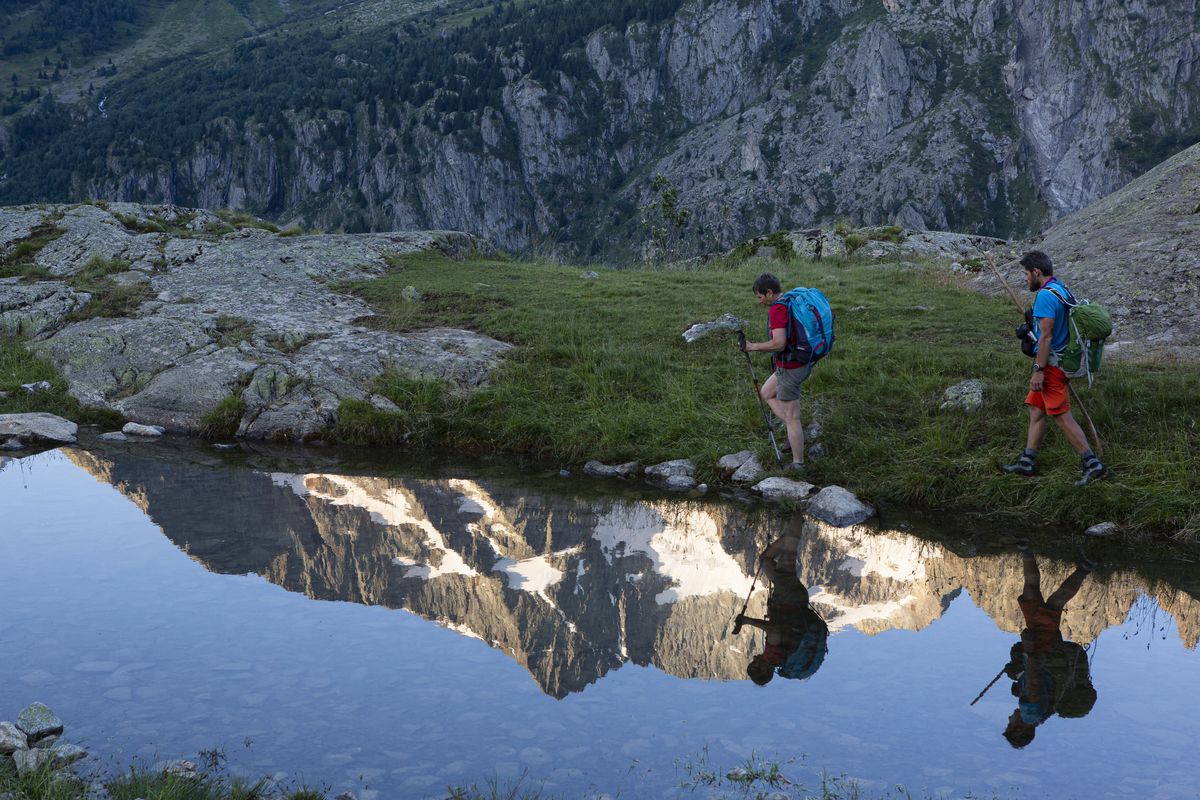
5. From La Ville to Plan du Lac
Miroir des Fétoules is a small lake where the mountain of the same name is reflected. The plant life is beautiful and the view stretches far over all the Vénéon valley. The ascent from Saint Christophe is rapid and it’s a nice place for a nap. Along the way, hikers are surrounded by former farming terraces, the silent witnesses of a hard life that no longer exists and that the vegetation is gradually taking over. Abandoned by mankind, today this is a semi-open environment that is rich in flora and fauna, a favourite spot for the many passerine birds whose song shows their presence.
Description
- At the end of the car park, continue straight on towards Miroir des Fétoules (signposted). Cross and then walk alongside the Diable mountain stream and then turn left into the path leading to Le Puy (signposted).
- At Miroir des Fétoules, you can make a return trip to the viewpoint indicator to the right (one hour). To go back down to Plan du Lac, turn left onto the pretty mountainside path leading to the village of Le Puy, go through it and the cross the former agricultural terraces.
- Just before arriving above the dam, turn left towards Plan du Lac (signposted). The path goes down through tight bends as far as the old road, where you turn right.
- About 50 metres further on, turn left toward the Plan du Lac gîte (signposted).
You arrive at the Plan du Lac gîte car park.
- Departure : La Ville
- Arrival : Plan du Lac gîte car park
- Towns crossed : Saint-Christophe-en-Oisans
6 points of interest

Bar-Hôtel de la Cordée à St-Christophe-en-Oisans Ville - © Parc national des Ecrins - Serge Derivaz  Know-how
Know-howAccommodation in Saint-Christophe-en-Oisans
Whether you at La Cordée or the Relais des Ecrins, you are in the commune of St-Christophe. Here you will be welcomed with simplicity, in a small village that has kept its charm and authenticity, with the mountain atmosphere absolutely everywhere and peacefulness abounding.
Marie-Claude Turc, the restaurant owner, whose grandparents opened La Cordée hotel in 1907, will delight you with the Creusets of St-Christophe, the valley's main speciality.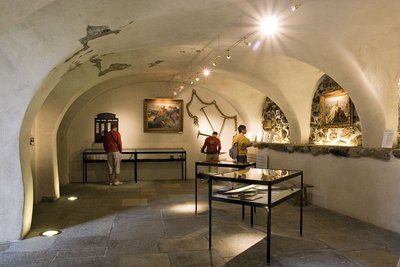
Musée Mémoires de l'alpinisme de St-Christophe-en-Oisans - © Parc national des Ecrins - Pascal Saulay  History
HistoryMusée Mémoires d'Alpinisme
At the centre of the village of Saint-Christophe en Oisans, the Mountain-Climbing Memorial Museum is a treasure trove of knowledge about the major figures who wrote the history of mountain-climbing in the Ecrins range . On the lower level is a large model of the mountain range, with numerous portraits of the pioneers and the equipment of the period. On the second level, the focus in on more recent climbing, with the exploration of tougher routes and a section devoted to the many women - often little known - who have taken part in the adventure of mountain climbing.
The third level is dedicated to temporary exhibitions about the Vénéon valley. This surprising museum is not to be missed !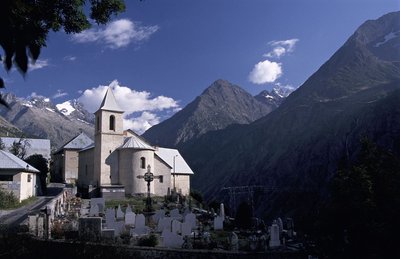
Eglise de St-Christophe-en-Oisans Ville - © Parc national des Ecrins - Denis Fiat  Vernacular heritage
Vernacular heritageSaint-Christophe-en-Oisans Church
The church houses a polychromatic wooden statue of Saint Christopher, and another polychromatic and gold wooden statue of the Virgin and child. Both statues date from the 17th century.
Make sure you visit the cemetery behind the church, where a large number of mountain climbers and guides, including the famous Pierre Gaspard, have their resting place.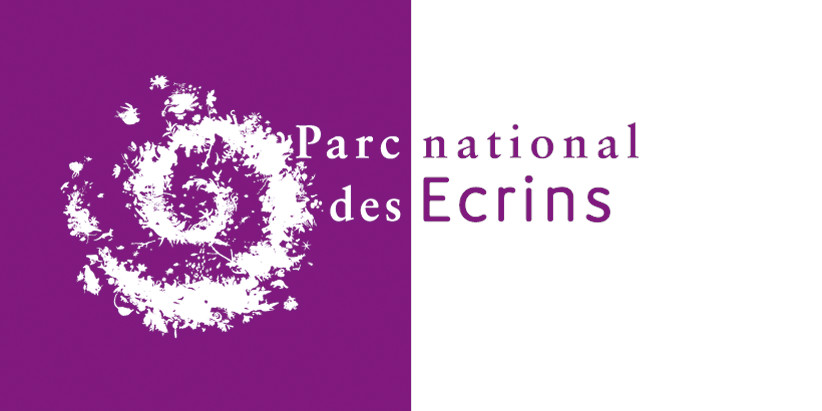
 Water
WaterFormation of a pool
In a mountain stream, the current tends naturally to create small irregularities. Whirlpools are formed, and together with the sediment carried along by the stream , they slowly deepen existing hollows until pebbles collect and are trapped inside them. The pebbles are continually churned around, digging the hollow deeper and deeper. Water can only get out when the hollows overflow. A pool is formed, and can grow to the size of a huge cauldron in certain cases. Pools can be formed one after the other in varying sizes depending on the location, and so create the highly sculpted rocky depths to be seen in some mountain streams.
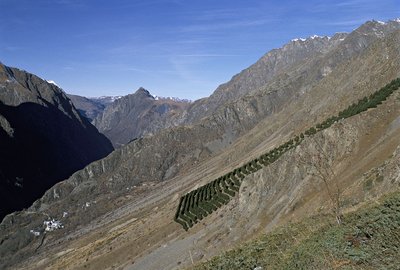
Plantation de résineux - © Parc national des Ecrins - Daniel Roche  Panorama
PanoramaPlanting resinous trees as a protection
Opposite, under the Plat de la Selle, a steep slope overlooking the village is planted with curiously well organised resinous trees. This is the work of the RTM, the Restauration des Terrains de Montagne (Restoration of Mountain Areas) agency, set up by Louis-Napoleon in 1860.
Planting resinous trees, which grow quickly and are resistant to cold, in particular, helps stabilise the soil. They prevent mudslides and provide a physical obstacle to snow, limiting the number of avalanches.
 History
HistoryAgricultural decline
In the mid-19th century, the population of the Alps was at its height. But the land was little productive and emigration ensued. The population naturally began to fall. Agriculture in the mountains also declined, and the First World War put a stop to most activity. The less accessible land was abandoned, since the men who went off to war were no longer there to work on it. After the war, the demand for industrial workers gave new perspectives to the Alpine populations, when compared with the hard, laborious work on the land. Today, we can date when the land was given up by estimating the age of the trees growing there.
Altimetric profile
Sensitive areas
Bearded vulture
- Impacted practices:
- Aerial, , Vertical
- Sensitivity periods:
- JanFebMarAprMayJunJulAugNovDec
- Contact:
- Parc National des Ecrins - Yoann Bunz- 06 99 77 37 65 yoann.bunz@ecrins-parcnational.fr
Bearded vulture
- Impacted practices:
- Aerial, , Vertical
- Sensitivity periods:
- JanFebMarAprMayJunJulAugNovDec
- Contact:
- Parc National des Ecrins - Yoann Bunz- 06 99 77 37 65 yoann.bunz@ecrins-parcnational.fr
Information desks
, 38520 Saint-Christophe-en-Oisans - La Bérarde
Oisans Park house
Rue Gambetta, 38520 Le Bourg d'Oisans
Video presentation of the natural resources of the Oisans mountain and its crafts. Information, documentation about the Park, projections, reading space for children. Accessible to people with reduced mobility. Free admission. All animations of the Park are free unless otherwise stated.
Source

Report a problem or an error
If you have found an error on this page or if you have noticed any problems during your hike, please report them to us here:


